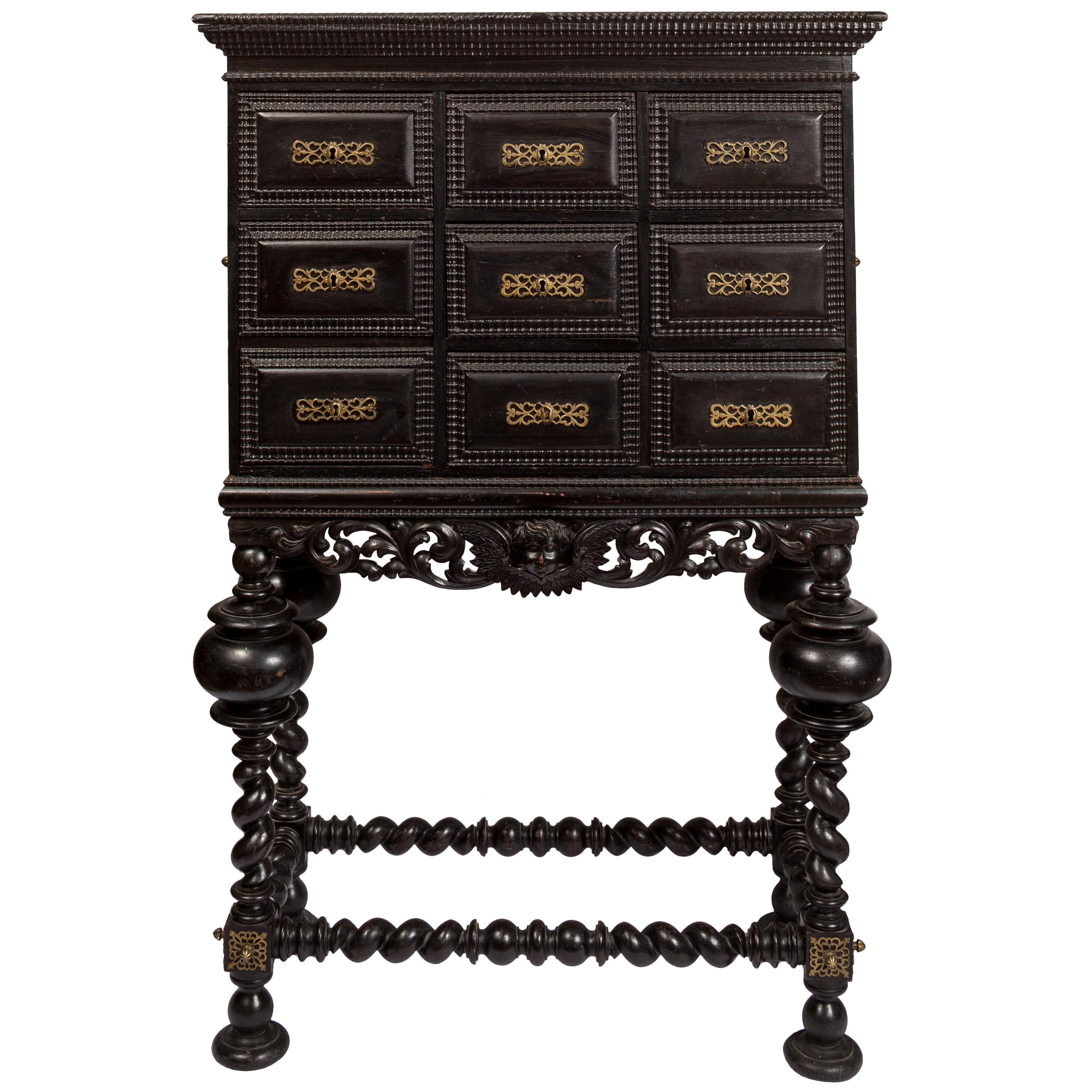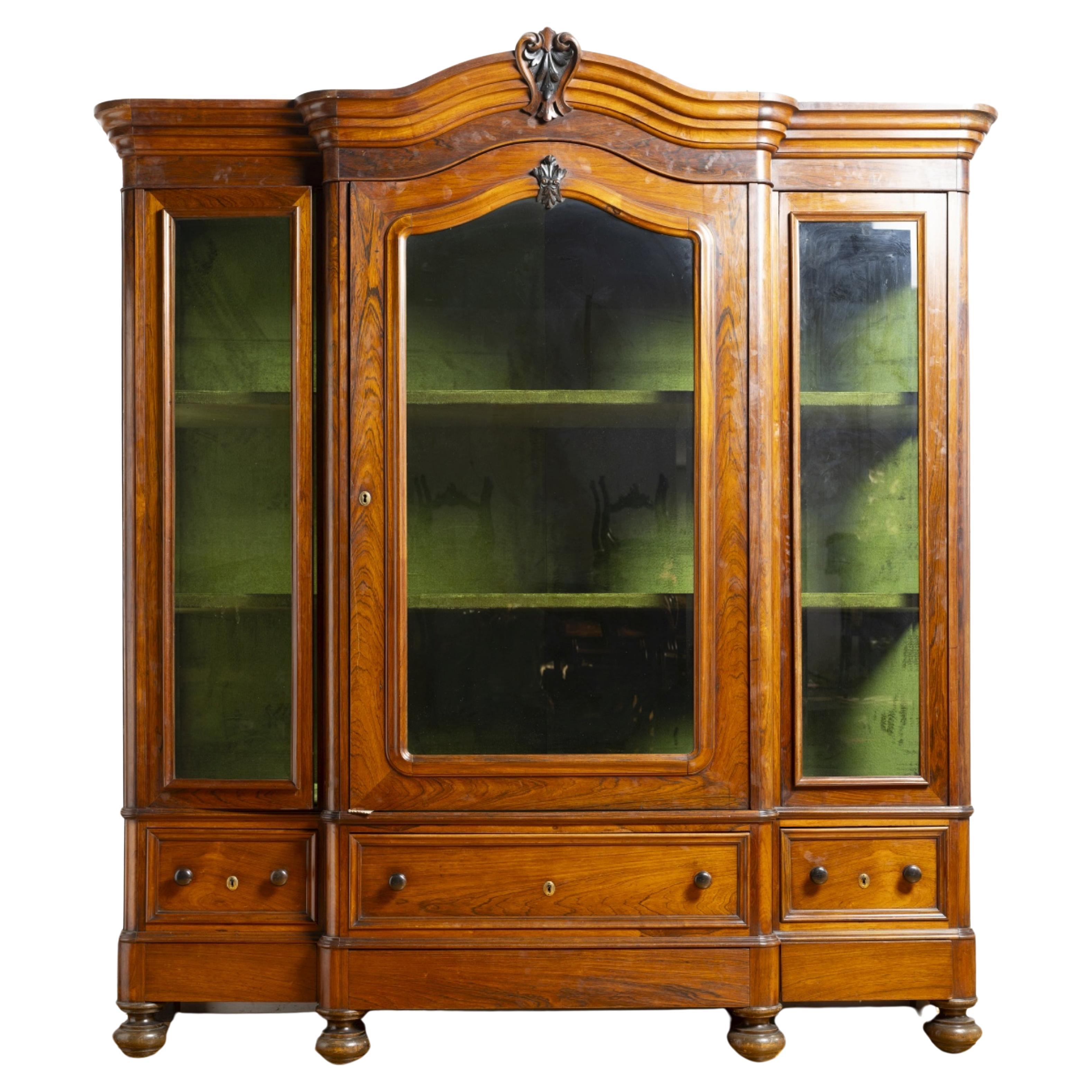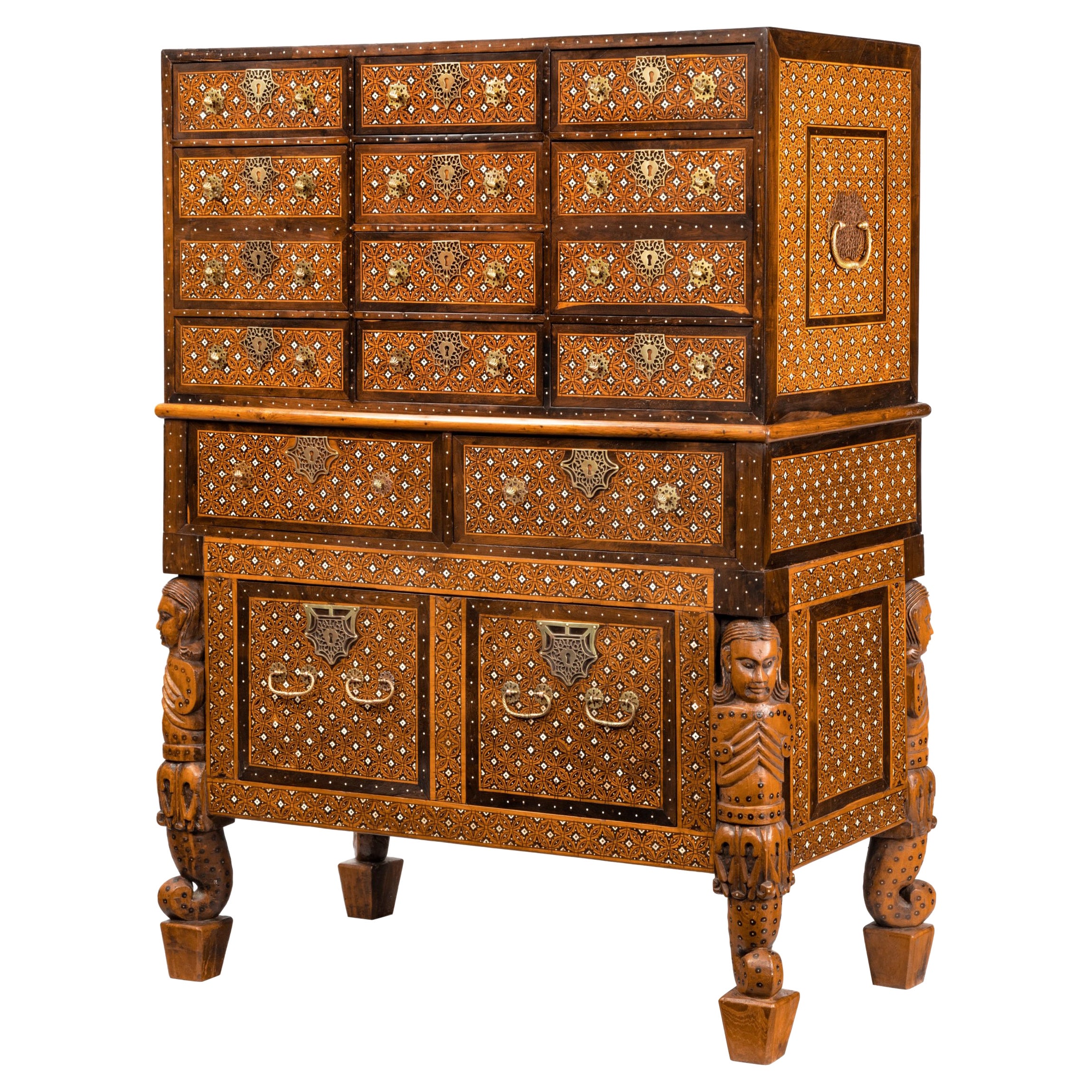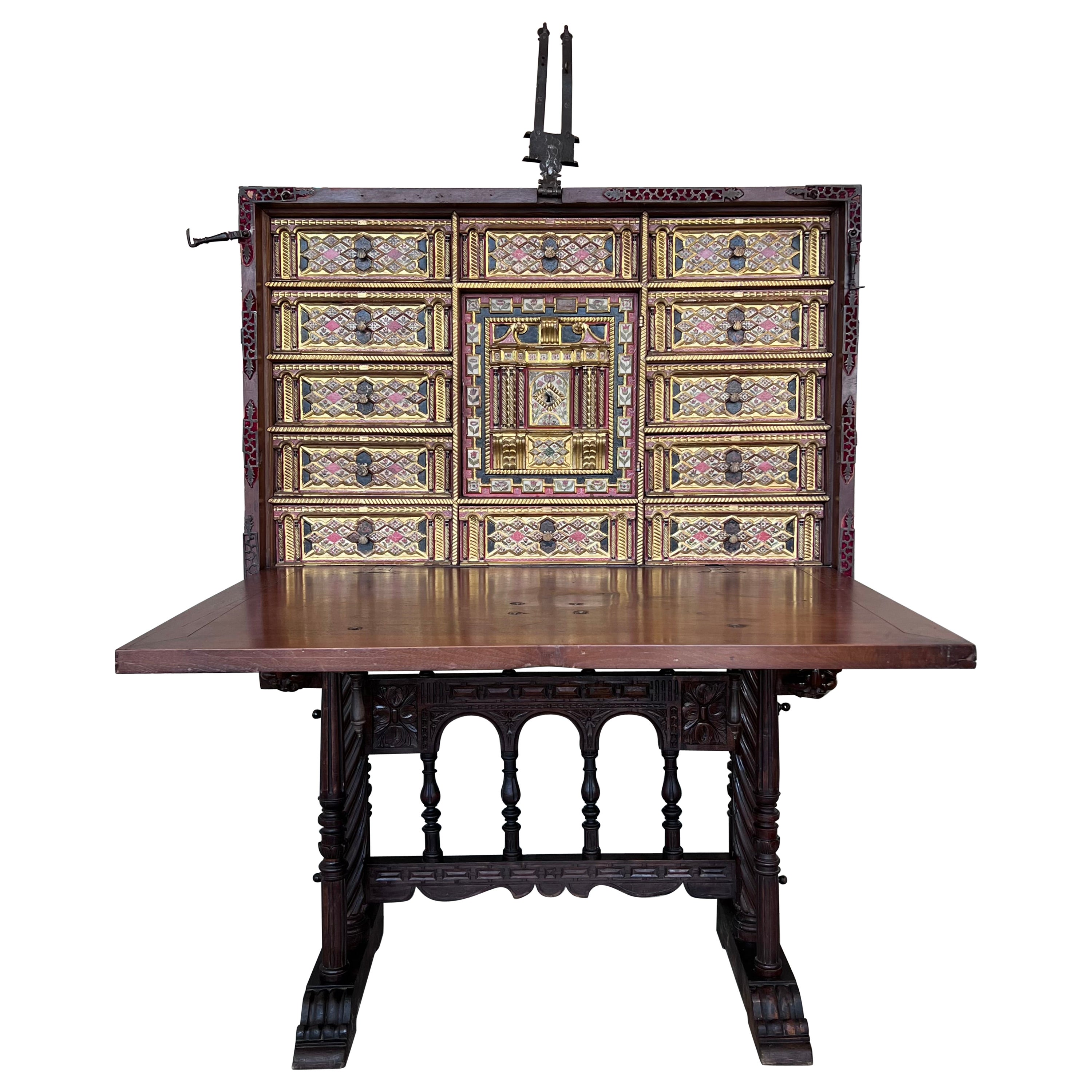Items Similar to Contador Cabinet Original Stand Rosewood Vinhático Portuguese Brass Tremidos
Want more images or videos?
Request additional images or videos from the seller
1 of 21
Contador Cabinet Original Stand Rosewood Vinhático Portuguese Brass Tremidos
About the Item
A STRIKING, MUSEUM QUALITY, BAROQUE, PORTUGUESE BRAZILIAN, ROSEWOOD & VINHÁTICO CONTADOR OR CABINET ON STAND WITH BRASS MOUNTS
- Masterpiece of carved ornament, with tremidos or fluted, ripple-effect drawer fronts, deep mouldings exhibiting a variety of intricate techniques & patterns, magnificent scrollwork apron on the stand and boldly, turned legs
- In exceptional condition retaining the original pierced brass mounts, locks, iron keys and elaborate carrying handles
- The pierced brassware creates reflective contrasts with the dark wood. This in combination with the variety of edges, patterns and forms creates interplay between light and shadow which is striking and illuminating, particularly at night.
- The front is fitted with four double and four single drawers simulating a front of twelve drawers to create symmetry.
- Original stand with magnificent, sculptural, scrollwork apron and boldly turned, multi-variant legs united by similarly turned stretchers on bun feet
- Much prized finely, figured hardwood grain which has not been coated with ebonised varnishes in the 19tht century as is customary. Retaining the original, rare, untouched patina.
- Private Collection, Lisbon by descent, reputedly in the house for hundreds of years, hence the original condition.
- This is as good an example of these elaborate Portuguese cabinets, which are virtuoso displays of carved and turned artistry, that I have ever seen.
- The tremidos or fluted, ripple-effect drawer fronts are carved in deep relief creating a striking visual effect of spacious movement within the front, reflecting light and shadow.
- The pierced brassware creates contrast in colour and enhance the depth of the relief and reflection of light.
- The deep mouldings exhibit a variety of sophisticated, intricate, carved, techniques and patterns framing the drawer fronts, sides, top and bottom of the cabinet, creating a rich, texture and tacticity.
- The crisply carved scrollwork front of the stand is magnificent and framed by the carving more modest carving on the sides
- The boldly turned legs create gravitas holding the presence of this extraordinary cabinet.
Length 93cm., 37 inches
Overall Height 147cm., 58 inches
Cabinet height 46cm., 18 inches
Depth 39cm., 15¼ inches
- Dimensions:Height: 57.88 in (147 cm)Width: 36.62 in (93 cm)Depth: 15.36 in (39 cm)
- Style:Baroque (Of the Period)
- Materials and Techniques:
- Place of Origin:
- Period:1650-1659
- Date of Manufacture:c1650
- Condition:Repaired: minor repairs to moulding losses. Wear consistent with age and use.
- Seller Location:BUNGAY, GB
- Reference Number:1stDibs: LU3867331927382
About the Seller
5.0
Vetted Seller
These experienced sellers undergo a comprehensive evaluation by our team of in-house experts.
Established in 1985
1stDibs seller since 2018
84 sales on 1stDibs
Typical response time: 7 hours
- ShippingRetrieving quote...Ships From: BUNGAY, United Kingdom
- Return PolicyA return for this item may be initiated within 7 days of delivery.
More From This SellerView All
- Cabinet Glazed Bookcase Display Stand Walnut Baroque Antiquarian BarleyLocated in BUNGAY, SUFFOLKUnusual, antiquarian, glazed, display cabinet or bookcase on stand in the Baroque-Style most likely made for a formal interior Beautifully made walnut cabinet piece using finely figu...Category
Antique Early 1900s English Baroque Revival Cabinets
MaterialsWalnut
- Chest, Cassone, 17th Century, Portuguese, Baroque, Brazil, HardwoodLocated in BUNGAY, SUFFOLKThis striking chest is made from a Brazilian hardwood which I have not been able to identify. The color and figuring of the timber together with the Classic form and ornamentation su...Category
Antique Late 17th Century Portuguese Baroque Blanket Chests
MaterialsHardwood
- Cassone Venetian 16thc Renaissance Cedar Original Stand Neptune Armorial UnicornLocated in BUNGAY, SUFFOLKA large, museum-quality, late-16th century, cedar, Venetian, cassone on its original stand ; the sea creature ornament probably drawn from De la Cosmographie Universelle, livre III, engraving 1550-1568 • This is the only, known, cassone of this type retaining its original stand. • The collection in Italy that it originally came from was a palazzo that it had reputedly been in for generations of the same family and this most likely why the stand has survived. • The decoration is very unusual, and delightful in the array of sea creatures depicted. The connection of the region with the sea is very strong. • The inner lid is very practical and can be used for display or serving. The interior offers masses of storage space which is particularly suitable for textiles being cedar which repels moths. • The cassone is a beautiful, rich colour and has developed a lustrous patina. • The cassone is Illustrated & discussed in discussed in ‘Woods in British Furniture Making’, (Bowett) c13 Provenance: Private collection, Mayorca. Private collection, Italy Related to: Cassone in V&A collection, no 4886-1858 Width 177 cm., 70 in., Height 87 cm., 34 ½ in. Depth 68 cm. 26 ½ in. With lid open 155 cm., 61 in “Late 16th and 17th century, London inventories confirm that cypress wood chests were relatively common in prosperous households. In 1598 there was a cypress chest in the hall of John Mason, a vintner, valued at 50 shillings. It was the most expensive piece of furniture in the house. Similarly there was a ‘fair cypress chest’ in the great chamber of Adrian Moore, haberdasher, in 1618, and a cypress chest worth £ 9 in the hall of Thomas Willis, a clotherworker in 1630. The chests were sometimes described as ‘great’ or ‘small’ but not otherwise described – presumably they were familiar to the compilers of the inventories. They were placed in halls, chambers and parlours, places where they would have been on prominent view. It is noteworthy that only the chests were imported and not, apparently, the wood. “ (p282, Cypress, Woods in British Furniture making) The decoration is very unusual, and delightful in the array of sea creatures depicted. The connection of the region with the sea is very strong. I have never seen one of these chests on its original stand. The collection in Italy that it came from was a palazzo that it had reputedly been in for generations of the same family and this most likely why the stand has survived. In practical terms, the stand makes the chest a comfortable height to use. The exterior of the chest is a beautiful, mellow colour and has developed a lustrous patina. The top comprises three planks faced with a shallow, cleated, moulded edge nailed on. The front retains its original hasp and lockplate and, as is commonly found, the lock has been removed but, unusually the original ring hinges have survived. The top opens to reveal an inner lid with ring hinges and a brass ring, revealing a large open storage compartment below, the bottom lined with an old fabric. The underside of the lid retains its original penwork and pierced decoration. The central panel depicts sea creatures, sharks, flatfish, monster fish, sea horses, Neptune and mermaids, probably drawn from De la Cosmographie Universelle, livre III, engraving 1550-1568. The panels either side depicting a crown, the sun and unicorns amongst stylised floral sprays. The surrounding naive penwork border features repeats of three naked ladies in the sea, a man wearing an animal mask with two dogs in a forest and a huntsman with two dogs. The floor of the inside of the cassone is upholstered in an 18th century red and yellow striped woven textile the colours of the Catalan flag. The front is decorated with pierced, silhouettes of beasts, trees and figures. The sides are plain with iron carrying handles. On its original stand, with similar decoration, and bearing a cartouche which would have been decorated with the arms of its original owner. Italian, last quarter of the 16th century. Condition Report : Old repair to bottom left moulding of top. Some hairline cracks to top. The hasp, lockplate and ring hinges are original, the lock has been removed. Handles probably 18th century. The inner lid was probably added in the 18th century and supporting mechanism in the 19th century. Exceptional original, lustrous colour and patina. Measures: Width 177 cm. 70 in., height 87 cm. 34 ½ in., depth 68 cm. 26 ½ in. The cassone was the principal piece of furniture in 16th century, Italy. These chests were made as bridal gifts for nobles and aristocrats from cedar specifically for storing their much prized and valued hangings, clothing and linens, as the wood repels moths and the sweet fragrance delicately scents fabrics. Consquently the cassone, as in this example might be decorated with the family coat of arms or with depictions of virtue and edifying episodes from the Bible. A young woman could not be allowed to enter marriage without some instruction. Later, many cassoni were taken apart so that the decorated front panel could be hung as a painting. The stand of this cassone has a cartouche that would have contained a painted coat of arms in the centre which shows that it was conceived for a noble family. Such cypress or cedar chests, incised in bas relief and pyrographically engraved, have long been associated with Venice and typically have a naïve decoration on the exterior. Literature: The 'cypress chests' containing 'arras, counterpoints, costely apparel, tents, and canopies, fine linen, Turkey cushions...Category
Antique 16th Century Italian Renaissance Cabinets
MaterialsCedar
- Casket, Box, Cabinet, Architectural, Ebonized, Alabaster, Secretdrawers, MalinesLocated in BUNGAY, SUFFOLKAn early 17th century, Flemish, Malines, ebonized and alabaster cabinet with removable sliding sides revealing secret drawers 12” long. The ebonized top with two carved alabaster ...Category
Antique 1630s Belgian Baroque Cabinets
MaterialsAlabaster
- Cabinet Spice Small Oak Cedar Snakewood Fruitwood Cushion Geometric MouldingLocated in BUNGAY, SUFFOLK- Particularly fine example with deep cushion and geometric mouldings. - Atmospheric piece with character - Secret drawers add intrigue A rare mid-17th century oak and cedar spi...Category
Antique 1650s English Baroque Cabinets
MaterialsFruitwood, Oak, Cedar
- Table Cabinet, Mid-17th Century, Flemish Baroque, Ebonized and TortoishellLocated in BUNGAY, SUFFOLKThis cabinet was made in Flanders in the mid-17th century as a prestigious item for an affluent member of the professional classes. The significant amount of tortoishell employed dem...Category
Antique Mid-17th Century European Baroque Cabinets
MaterialsTortoise Shell
You May Also Like
- Black / Ebonized Portuguese 'Contador' Cabinet with Matching Decorative StandLocated in Madrid, ESSimilar in concept to the Spanish bargueño, the Portuguese "contador" cabinet started out as a small portable chest of drawers used for storing valuable...Category
Antique 18th Century Portuguese Baroque Cabinets
MaterialsBrass
- IMPORTANT LARGE DISPLAY PORTUGUESE CABINET 19th Century Rosewood WoodBy Europa AntiquesLocated in Madrid, ESLARGE DISPLAY CABINET 19th Century rosewood wood with three doors, glass sides and three drawers. Interior with two shelves covered in velvet in shades of green. Dim.: 235 x 191 x 6...Category
Antique 19th Century Portuguese Baroque Cabinets
MaterialsRosewood
- Indo-Portuguese Rosewood, Teak and Ebony ContadorLocated in Lymington, HampshireThis chest on chest is of rectangular form in two sections. The upper section has twelve similar drawers in four registers and carrying handles on the sides. The base has a pair of frieze drawers above a single deep drawer, disguised as a pair, with four handles and flanked by carved Nagini whose monopodia scroll supports are raised on blocks to form the feet. The whole piece is decorated with an overall pattern of interlaced stars and circles embellished with ebony and ivory dots and is applied with brass handles and lock escutcheons. Goanese, circa 1800. This contador blends the traditional form of Western...Category
Antique Early 1800s Indian Commodes and Chests of Drawers
MaterialsEbony, Rosewood, Teak
- Rare Portuguese 18th Century CabinetBy Europa AntiquesLocated in Madrid, ESPortuguese 18th century cabinet Made of kingwood. Three drawers simulating four. Base with profusely decorated skirts with plant motifs, turned legs a...Category
Antique 18th Century Portuguese Baroque Cabinets
MaterialsWood
- 17th Spanish Walnut Cabinet on Stand, Desk, Original ‘Bargueño’Located in Miami, FLSpanish desk (“bargueño”) in walnut. 17th century with “bridge-shapped”. Decorated on the exterior with metal applications (open-work, textile background) and bow handles with central lentil. It stands on a "foot bridge...Category
Antique 17th Century Spanish Baroque Cabinets
MaterialsWalnut
- 17th Spanish Walnut Cabinet on Stand, Desk, Original ‘Bargueño’Located in Miami, FLSpanish desk (“bargueño”) in walnut. 17th century with “bridge-shapped”. Decorated on the exterior with metal applications (open-work, textile background) and bow handles with centr...Category
Antique 17th Century Spanish Baroque Cabinets
MaterialsWalnut
Recently Viewed
View AllMore Ways To Browse
Portugal Brass
Antique Kitchen Stand
Antique Brass Collection
Antique Brass Locks
Brass Antique Locks
Deep Relief
Dark Antique Brass
Museum Cabinet
Cabinet On Turned Legs
Antique Light Stand
Brass Turn Handle
Iron Key
Pierced Cabinet
Antique Carrying Case
Rosewood With Brass Legs
Fluted Side Cabinet
Exhibit Case
Antique Color Kitchen Cabinets





